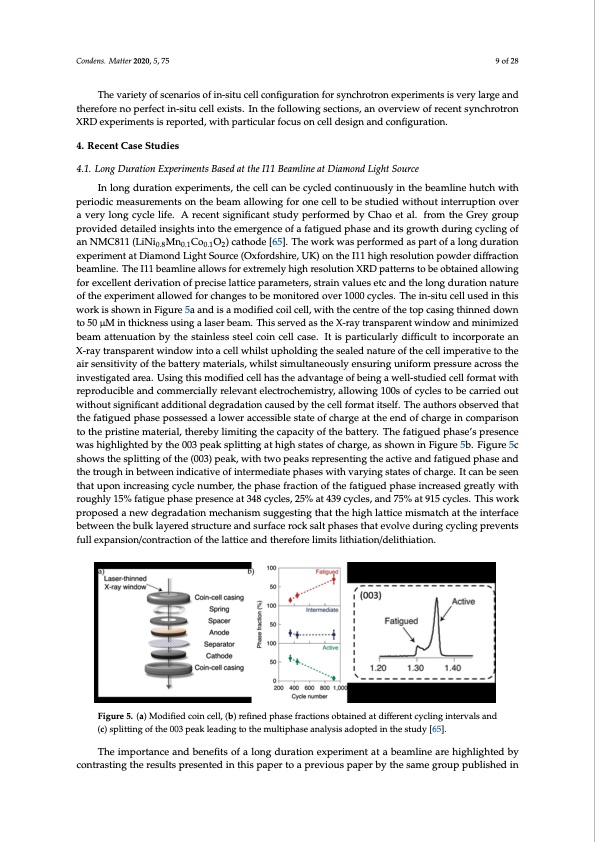
PDF Publication Title:
Text from PDF Page: 009
Condens. Matter 2020, 5, 75 9 of 28 The variety of scenarios of in-situ cell configuration for synchrotron experiments is very large and therefore no perfect in-situ cell exists. In the following sections, an overview of recent synchrotron XRD experiments is reported, with particular focus on cell design and configuration. 4. Recent Case Studies 4.1. Long Duration Experiments Based at the I11 Beamline at Diamond Light Source In long duration experiments, the cell can be cycled continuously in the beamline hutch with periodic measurements on the beam allowing for one cell to be studied without interruption over a very long cycle life. A recent significant study performed by Chao et al. from the Grey group provided detailed insights into the emergence of a fatigued phase and its growth during cycling of an NMC811 (LiNi0.8Mn0.1Co0.1O2) cathode [65]. The work was performed as part of a long duration experiment at Diamond Light Source (Oxfordshire, UK) on the I11 high resolution powder diffraction beamline. The I11 beamline allows for extremely high resolution XRD patterns to be obtained allowing for excellent derivation of precise lattice parameters, strain values etc and the long duration nature of the experiment allowed for changes to be monitored over 1000 cycles. The in-situ cell used in this work is shown in Figure 5a and is a modified coil cell, with the centre of the top casing thinned down to 50 μM in thickness using a laser beam. This served as the X-ray transparent window and minimized beam attenuation by the stainless steel coin cell case. It is particularly difficult to incorporate an X-ray transparent window into a cell whilst upholding the sealed nature of the cell imperative to the air sensitivity of the battery materials, whilst simultaneously ensuring uniform pressure across the investigated area. Using this modified cell has the advantage of being a well-studied cell format with reproducible and commercially relevant electrochemistry, allowing 100s of cycles to be carried out without significant additional degradation caused by the cell format itself. The authors observed that the fatigued phase possessed a lower accessible state of charge at the end of charge in comparison to the pristine material, thereby limiting the capacity of the battery. The fatigued phase’s presence was highlighted by the 003 peak splitting at high states of charge, as shown in Figure 5b. Figure 5c shows the splitting of the (003) peak, with two peaks representing the active and fatigued phase and the trough in between indicative of intermediate phases with varying states of charge. It can be seen that upon increasing cycle number, the phase fraction of the fatigued phase increased greatly with roughly 15% fatigue phase presence at 348 cycles, 25% at 439 cycles, and 75% at 915 cycles. This work proposed a new degradation mechanism suggesting that the high lattice mismatch at the interface between the bulk layered structure and surface rock salt phases that evolve during cycling prevents full expansion/contraction of the lattice and therefore limits lithiation/delithiation. Condens. Matter 2020, 5, x 10 of 30 Figure 5. (a) Modified coin cell, (b) refined phase fractions obtained at different cycling intervals and Figure 5. (a) Modified coin cell, (b) refined phase fractions obtained at different cycling intervals and (c) splitting of the 003 peak leading to the multiphase analysis adopted in the study [65]. (c) splitting of the 003 peak leading to the multiphase analysis adopted in the study [65]. The importance and benefits of a long duration experiment at a beamline are highlighted by The importance and benefits of a long duration experiment at a beamline are highlighted by contrasting the results presented in this paper to a previous paper by the same group published in contrasting the results presented in this paper to a previous paper by the same group published in 2019 [66]. The study performed operando XRD during the first charge of NMC811 using the AMPIX cells and did not identify the presence of any fatigued phases during(de)lithiation of NMC811 cathodes. The long duration experiment allowed for the evolution of this multi-phase behaviour upon electrochemical aging to be observed and its evolution with cycling studied. The position of the (003) peak for NMC811 indirectly correlates with state-of-charge. The state- of-charge of all solid state batteries has also been determined using X-ray diffraction in reference [67].PDF Image | Synchrotron-Based X-ray Diffraction for Lithium-Ion Batteries

PDF Search Title:
Synchrotron-Based X-ray Diffraction for Lithium-Ion BatteriesOriginal File Name Searched:
condensedmatter-05-00075.pdfDIY PDF Search: Google It | Yahoo | Bing
Sulfur Deposition on Carbon Nanofibers using Supercritical CO2 Sulfur Deposition on Carbon Nanofibers using Supercritical CO2. Gamma sulfur also known as mother of pearl sulfur and nacreous sulfur... More Info
CO2 Organic Rankine Cycle Experimenter Platform The supercritical CO2 phase change system is both a heat pump and organic rankine cycle which can be used for those purposes and as a supercritical extractor for advanced subcritical and supercritical extraction technology. Uses include producing nanoparticles, precious metal CO2 extraction, lithium battery recycling, and other applications... More Info
| CONTACT TEL: 608-238-6001 Email: greg@infinityturbine.com | RSS | AMP |